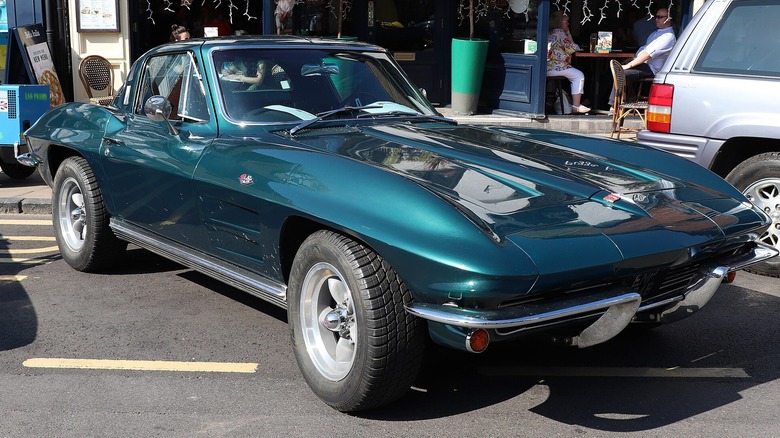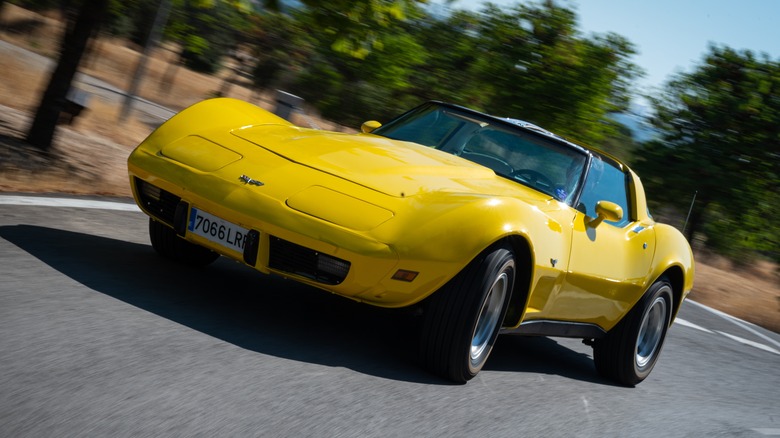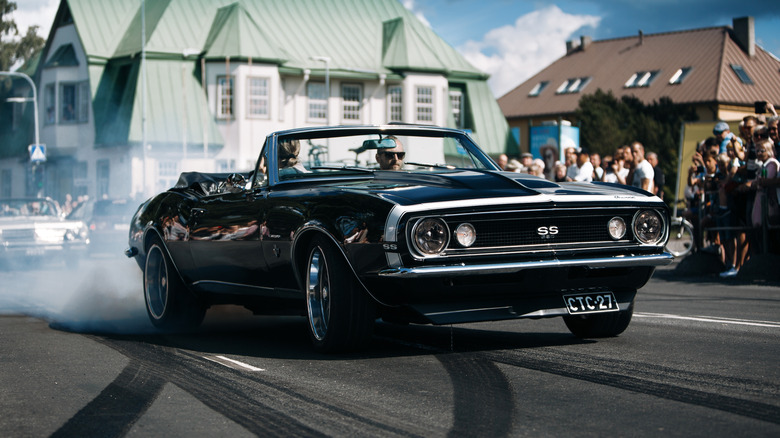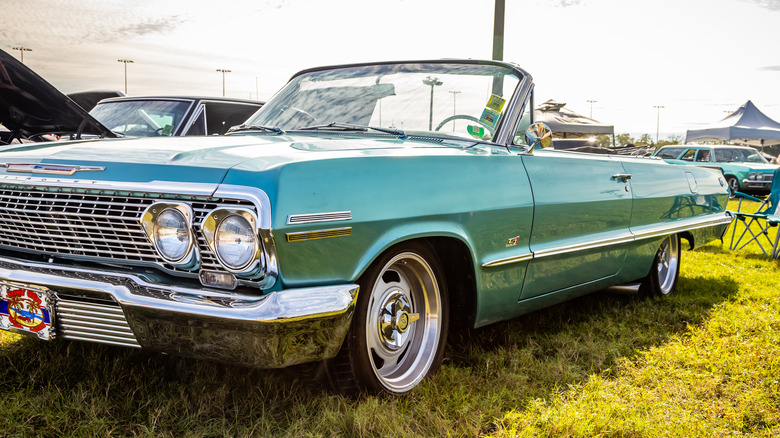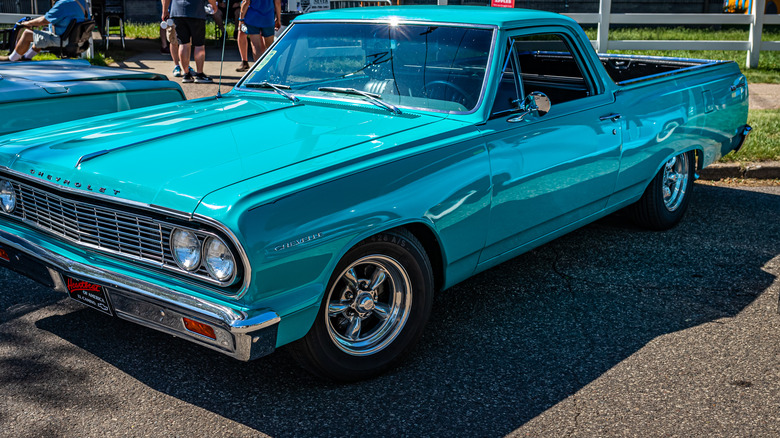The Most Iconic Chevy Models From The 1960s
When Bob Dylan sang, "you better start swimmin' or you'll sink like a stone, for the times they are a-changin," he couldn't have found a better lyric to describe Chevrolet during the 1960s. It was a decade when the music was growing louder, the parties were getting weirder, and the more people were looking to the automobile as a means of expressing their own individuality.
Throughout the '60s Chevrolet experienced its own unique transition, moving away from the heavy, tank-like builds of the 1950s toward what would be the sleek, edgy designs that were a staple in the 1970s, while meeting the challenges of market demands. At this time, it was speed, power, and customization that propelled industry-wide innovation. Competition was high to provide maximum performance at the cheapest price, with the average car at the time costing $2,752. And with the Baby Boomer generation having recently snagged their driving licenses, a growing interest in "muscle cars" — cars with the ability to accelerate quickly — was steadily on the rise.
In working toward solving these demands, Chevrolet created a number of incomparable cars that left a lasting legacy in American culture. Here are some of the top four most memorable models of the 1960s.
[Featured image by Vauxford via Wikimedia Commons | Cropped and scaled | CC BY-SA 4.0]
1968 C3 Corvette
Starting off with the "shark" of the group, the 1968 C3 Corvette was every bit distinctive as it was controversial. Designed by Larry Shinoda, the original Corvette model was styled off of the Mako shark with its raised tail and sleek, elevated edges. Yet despite the popularity of the previous C2 generation, Chevrolet completely revamped the layout of the C3 with brand-new components like the first-ever removable T-top roof panels and rear-window. Despite mixed reviews of the noisy cockpit and lack of cargo space, the '68 Corvette sold a whopping 28,566 units in its first run, and continued to become a hot commodity as the decade progressed.
Throughout the '60s the Corvette developed a unique relationship with NASA that started with gifting a brand new 1962 Corvette to Alan Shepard upon his return from space. Jim Rathmann, the owner of a Chevrolet/Cadillac dealership in Melbourne, Florida, then took it a step further when he leased top of the line Corvette models to all seven members of the Mercury 7 team at the bargain leasing price of $1 a year. From that point on, it became a tradition for the astronauts to take these fast cars out for a spin, racing each other up and down the sandy Cape when they weren't training. Of the '68 models, Jim Lovell, commander of the ill-fated Apollo 13 lunar mission, drove a Silverstone Silver 1968 Corvette.
1967 Camaro
Built as a two-year later response to Ford's release of the Mustang, the 1967 Camaro was created out of rigid design restrictions that Chevrolet imposed in order to keep costs down. This lead to some unique features that became an indelible part of this "pony" car's legacy, such as its boxy frame, round disappearing headlights, and the use of a semi-unitized body. With this design, everything in front of the firewall of the vehicle could be easily removed and replaced, while components positioned behind were integrated into the entire body. The integration of a semi-unitized body in the Camaro would later prove a huge boon to restomod project car enthusiasts.
Another interesting element of the Camaro was that it was the first model to house the fresh fat-block engine, just in time for the upcoming racing Winternationals. Prior to its release, the SCCA created the Trans-Am sedan racing class, which would provide a category for the Camaro to compete. With the introduction of the Z/28 Camaro sporting a 285 crankshaft in a 350 block-engine, Chevrolet went on to win back-to-back 1968 and 1969 Trans-Am Championships despite its policy against racing sponsorships — an interesting achievement covered more in-depth in this SlashGear article about important facts of the 1967 Camaro. Ever since its creation, the Camaro has become a reliable and resilient fixture in American automotive culture, from joining the ranks of the 1968 Hot Wheels "Sweet Sixteen" edition to making an explosive entrance on screen as the dependable, yellow-hued Bumblebee in 2007s "Transformers."
1963 Impala
In terms of a muscle car model that could win the title "Most Popular" of the decade, look no further than the 1963 Chevy Impala. The '60s marked a period of all-time high sales for the Impala, with more than a million sold nationwide in just 1965 alone. One type of the '63 Impala, the Z11, which made SlashGear's list of the rarest Chevys to collect, had a particular set of unique features that were rare for the time.
It came with an array of distinguishing features including a 427 cubic inch V8 engine capable of 430 hp, an aluminum intake manifold, and a set of dual four-barrel carburetors. The big block 427 engine on the Z11 would become a part of a line of big block engines, nicknamed the "Mystery Motors", that quickly elevated engine capacity and quality in Chevrolet muscle cars. Allegedly, only a total of 50 units of the Z11 ever left the factory floor, which has dwindled down to only a sprinkling left in use as of 2023.
One of the main reasons Chevrolet prioritized the manufacture of the Impala Z11 was to compete against the then-dominant Ford Thunderbolt in the factory drag racing scene. To add a competitive edge, this model's components like the hood, roof, and bumpers were made out of aluminum instead of steel, cutting weight by 300 pounds. Interestingly, the Z11 ended up being driven by Joie Chitwood Jr., an icon in racing who later orchestrated the stunts for the James Bond film "Live and Let Die," as well as hosted the widely popular "Joie Chitwood Thrill Show,"
1964 El Camino
In the category of car-truck vehicles, no automaker has quite left behind the iconic status set by the 1967 El Camino and its perfectly blended business in the front, party in the back mullet style. At the time, the first generation of the El Camino was struggling to match Chevrolet's sales expectations. So the automaker took a pragmatic approach to the model's rugged face-lift, taking the already successful design of the Chevelle and simply adding a truck bed.
Like with the Camaro, Chevrolet was striving to compete against the success of Ford's Ranchero, hence the decision to copy the Spanish name choice and stylistic utility blend. Chevy's truck-sedan hybrid boasted a robust four-link rear suspension and airshocks to help increase durability in hauling large loads. Like with all Chevrolet models in the '60s, there were a number of engine configurations customers could select for their El Camino, maxing out at the 396 V8 engine that topped at 375 hp.
The El Camino also had its fair share of high-profile cinematic exposure. The model underwent a second wave of popularity when the 1971 dark comedy "Harold and Maude" hit the theaters, in which there is a famous scene where Maude rockets an El Camino straight through a police toll-booth station. While the El Camino was discontinued in 1968, its legacy lives on to this day.
